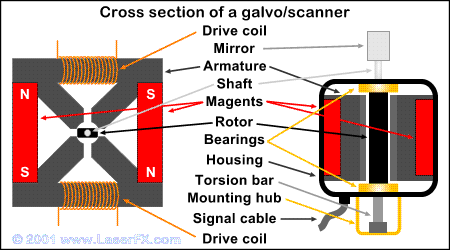Discovering the Advanced Attributes of Modern Galvanometer Scanners in Study
Discovering the Advanced Attributes of Modern Galvanometer Scanners in Study
Blog Article
Secret Applications of a Galvanometer Scanner in Different Scientific Research Area
Galvanometer scanners have ended up being indispensable to various scientific study fields, providing improved accuracy in applications varying from biomedical imaging to environmental tracking. Their capacity to promote high-resolution imaging techniques, such as confocal microscopy, plays an essential role ahead of time our understanding of mobile frameworks. In material handling, these tools enhance the precision of laser cutting and welding. As we check out the diverse applications of galvanometer scanners, it comes to be apparent that their effect prolongs much past plain technological capacities, questioning about their future capacity in arising research study locations.
Biomedical Imaging

In confocal microscopy, galvanometer scanners facilitate the procurement of images with boosted resolution and comparison, permitting scientists to envision mobile elements in vivo. The ability to rapidly catch numerous focal planes boosts the three-dimensional reconstruction of tissues, supplying essential understandings right into their architecture and feature.

In addition, the fast scanning capacities of galvanometer systems add to advancements in dynamic imaging applications, such as checking mobile responses to stimulations. Galvanometer scanners are essential devices in the area of biomedical imaging, advancing research and medical diagnostics through their precision and effectiveness.
Product Processing
Accuracy in product handling is important for achieving high-grade results in numerous commercial applications (galvanometer scanner). Galvanometer scanners play a vital function in improving this accuracy by making it possible for quick and accurate movement control during the handling of materials such as polymers, metals, and ceramics. These devices help with strategies like laser inscription, welding, and cutting, which require finely-tuned modifications to make certain ideal end results
In laser cutting, as an example, galvanometer scanners enable detailed layouts to be performed with high integrity, decreasing waste and boosting production effectiveness. The quick activity abilities allow quick modifications in the laser light beam path, which is vital for preserving consistent cutting high quality throughout varying product thicknesses. Likewise, in laser welding applications, the precision offered by galvanometer scanners guarantees solid joints with very little thermal distortion, thereby boosting structural stability.
Furthermore, the versatility of galvanometer scanners to different laser types and wavelengths further widens their utility in product processing. Their capability to operate in tandem with innovative software application for real-time monitoring and control adds an added layer of sophistication, enabling producers to accomplish exact specs customized to certain applications. Hence, galvanometer scanners are important ahead of time the capacities of product handling innovations.
Optical Characterization
In the realm of optical characterization, the role of galvanometer scanners comes to be significantly significant as they assist in the evaluation of different optical residential or commercial properties with high precision. These devices make it possible for specific control of laser beams, enabling scientists to systematically probe products at several angles and regularities. This capacity is vital for webpage defining the refractive index, absorption coefficient, and spreading properties of varied materials.
Galvanometer scanners are especially effective in methods such as optical comprehensibility tomography (OCT) and laser-induced fluorescence (LIF), where rapid scanning is important. By accomplishing high-speed inflection of the laser placement, galvanometer scanners enhance the temporal resolution of these techniques, causing enhanced imaging and analysis. Furthermore, they allow the exploration of complex interactions in between light and issue, which is essential for comprehending material actions under numerous problems.
Moreover, the combination of galvanometer scanners with spectroscopic methods increases their energy, enabling detailed spooky evaluation across a large range of wavelengths. This versatility makes them important devices in areas such as products science, biomedical research study, and nanotechnology, where thorough optical characterization is paramount for progressing expertise and advancement.

Laser Micromachining
The development of laser micromachining has actually revolutionized making procedures, allowing the development of complex structures with unparalleled accuracy. This technique utilizes high-intensity laser beam of lights to specifically eliminate material from a substratum, making it feasible to produce micro-scale elements that are important in different sectors. The application of galvanometer scanners in laser micromachining boosts the effectiveness and accuracy of this process by enabling fast and exact beam of light positioning.
Galvanometer scanners facilitate the vibrant control of laser light beams, allowing look here intricate patterns to be etched or cut with high fidelity. Their fast feedback times and high-resolution capabilities enable the manipulation of laser pulses, which is necessary for achieving the desired material buildings and surface finishes. This technology is particularly beneficial in markets such as electronic devices, where the miniaturization of components is essential for performance enhancement.
In addition, laser micromachining is increasingly being used in the clinical area for making precision instruments and implants. The combination of laser technology and galvanometer scanning not just streamlines production workflows however likewise decreases waste and improves total product application, making it a lasting option for modern-day manufacturing challenges.
Ecological Monitoring
Environmental monitoring has become increasingly vital in analyzing and taking care of the wellness of communities and urban atmospheres. The assimilation of galvanometer scanners in this area allows precise, fast, and reliable data collection, promoting far better decision-making processes. These scanners are adept at guiding laser beams or sensing units throughout different terrains, permitting high-resolution mapping of environmental criteria such as air quality, dirt make-up, and water pollution.
In air high quality surveillance, galvanometer scanners can be used to evaluate particulate matter and gaseous toxins, providing real-time data that educates public health campaigns. For water high quality analyses, these scanners can assist in spotting contaminants and determining physical criteria, consequently making sure compliance with ecological policies. Furthermore, in remote picking up applications, galvanometer scanners boost the ability of satellite and drone systems to catch comprehensive photos and data of huge locations, identifying ecological adjustments and anthropogenic influences.
The adaptability and accuracy of galvanometer scanners make them essential tools in ecological surveillance, adding significantly to sustainable development initiatives and the security of natural sources. As the demand for efficient ecological administration expands, the role of these advanced gadgets will definitely increase even more.
Conclusion
In summary, galvanometer scanners function as vital devices across multiple clinical research domain names. Their application in biomedical imaging improves the precision of methods vital for mobile visualization and diagnostics. In product handling, these scanners promote advanced laser cutting and welding processes, ensuring minimal distortion. In addition, their role in environmental tracking underscores the significance of accurate data collection in addressing public health and ecological obstacles. The versatility and performance of galvanometer scanners remain to drive innovations in these important areas.
In laser welding applications, the accuracy supplied by galvanometer scanners ensures solid joints with visit site very little thermal distortion, consequently enhancing structural integrity.
In addition, the adaptability of galvanometer scanners to different laser types and wavelengths even more expands their energy in material processing. By accomplishing high-speed modulation of the laser position, galvanometer scanners improve the temporal resolution of these approaches, leading to boosted imaging and evaluation. The application of galvanometer scanners in laser micromachining improves the efficiency and accuracy of this procedure by allowing fast and exact beam positioning.
Galvanometer scanners promote the dynamic control of laser beam of lights, making it possible for complicated patterns to be engraved or reduced with high fidelity.
Report this page